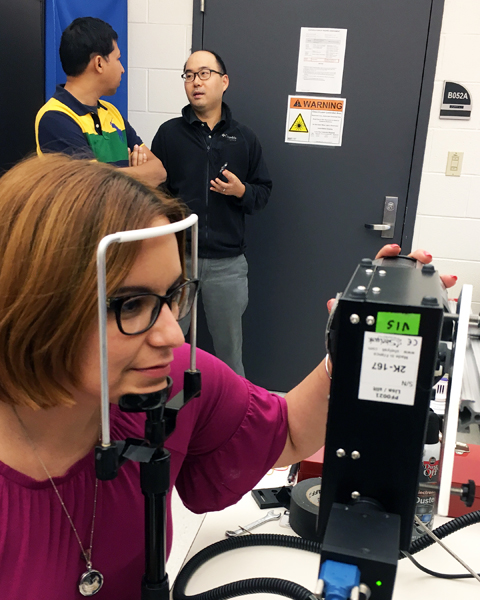Purdue researchers receive grant to improve mobile testing for anemia

The grant expands preliminary research funded by the Regenstrief Center, and by an I2D Lab Seed Grant from the Purdue Global Engineering Program, to investigate the possibility of equipping mobile smartphones with a program to analyze blood hemoglobin content for levels of anemia and to measure those levels with the accuracy of conventional blood tests.
Although portable, or point-of-care, blood analyzers exist, they remain unaffordable and inadequate in developing countries, where pregnant women, women of childbearing age and young children are especially vulnerable to the condition. Anemia, which is defined as a decrease in red blood cells, can influence outcomes in both mother and child, including maternal mortality, decreased cognitive function, low birth weight, heart failure and delayed infant development.
Anemia is a global public health problem, affecting more than 2 billion people worldwide, including 50 percent of pregnant women and 69 percent of preschool children in Kenya, East Africa, where development and testing of sHEA — smartphone-based bloodless spectrometerless HEemoglobin Analyzer technology — will be aided by AMPATH, the Academic Model Providing Access to Healthcare. AMPATH is a consortium of academic health institutions, including Purdue and the Indiana University School of Medicine, that have joined together to partner with Kenya-based Moi Hospital and University to tackle the challenges of disease and poverty.
“This study combines medical device development, clinical laboratory testing, computer science, and cultural sensitivity,” said Kim. “Partnering with AMPATH allows us to reach a severely affected population in order to fine-tune sHEA and make reliable, portable anemia testing an option for Kenya.”
Traditionally, accurate and precise Hgb measurements have relied on the use of spectrometers and spectrographs. Conversely, sHEA hemoglobin-measuring technology does not require an attachment (such as external spectrometric instruments) to the smartphone, but relies solely on a smartphone camera snapshot of the patient’s lowered eyelid, with the color of the eyelid’s microvasculature serving to indicate the level of anemia. Basically, an “eyelid selfie.”
Conventional smartphones and their RGB (red-green-blue) additive color model capability, however, can’t adequately capture the data necessary to detect and measure anemia. Instead, color data from the smartphone must be translated into virtual hyperspectral images that include detailed color information. This translation requires the creation of a two-step algorithm.
Previously, Kim was part of research team that developed predictive modeling for detecting anemia in cattle by translating the spectral measurements of calves’ eyelids into virtual hyperspectral images using combined full spectral reconstruction data and advanced regression.
Predictive modeling for human anemia testing will require a pool of a large number of patients to be tested through traditional blood analysis, or a complete blood count (CBC), along with non-invasive spectral analysis at the AMPATH laboratory. Results of the study will provide validation for the intervention, and be used to create a hemoglobin-detection algorithm for humans that can be embedded within an electronic health records system-integrated smartphone application. Next year, researchers expect to have the pilot sHEA smartphone application available to Kenya health care workers for testing in the field.
Other members of the research team include Martin Were, associate professor of biomedical informatics at Vanderbilt University; and Abraham Siika, and Violet Naanyu, with the USAID-AMPATH Partnership in Kenya.
Source: Purdue Newsroom
